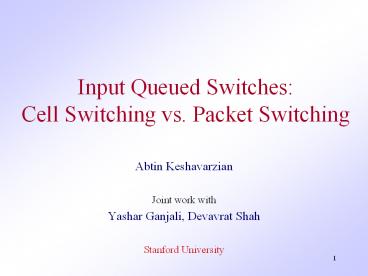Input%20Queued%20Switches:%20Cell%20Switching%20vs.%20Packet%20Switching - PowerPoint PPT Presentation
Title:
Input%20Queued%20Switches:%20Cell%20Switching%20vs.%20Packet%20Switching
Description:
Work Conserving. Waiting. Waiting PB Algorithms. Conclusion. 5 ... Conserving ... Work-conserving packet based algorithms can not be rate stable for all ... – PowerPoint PPT presentation
Number of Views:138
Avg rating:3.0/5.0
Title: Input%20Queued%20Switches:%20Cell%20Switching%20vs.%20Packet%20Switching
1
Input Queued SwitchesCell Switching vs. Packet
Switching
- Abtin Keshavarzian
- Joint work with
- Yashar Ganjali, Devavrat Shah
- Stanford University
2
Background
Switching Fabric
- Time is slotted
- Data units of fixed size ? cells
- Buffers at input ports (Input-Queued Switch)
- To avoid HoL blocking , virtual output queues are
used
3
Motivation
Switch
VOQ11
Combiner
VOQ1N
Splitter
VOQN1
VOQNN
- Packets have different lengths
- Splitter module
- Combiner module (memory)
- Packet delays are more important than Cell delays
- Packet Based Scheduling algorithms
4
Outline
- Cell based algorithms review
- Stability concept
- Maximum Weight Matching algorithm
- Packet based algorithms
- Packet-Based Algorithms
- PB-MWM and its stability
- PB Algorithms Classification
- Work Conserving
- Waiting
- Waiting PB Algorithms
- Conclusion
5
Notation Arrival rate
Switching Fabric
- Number of cells arrived to VOQij up to
time n - Number of cells departed from VOQij up
to time n - Number of cells queued at VOQij at time
n - (SLLN)
almost surely
6
Admissibility and Rate Stability
- The arrival rate matrix is
admissible iff - A switch under a matching algorithm is stable
(rate stable) if, almost surely,
7
MWM algorithm
- A matching
- MWM At each time slot, select the matching with
maximum weight
8
MWM Stability
- McKeown et al showed that
- MWM is stable under i.i.d. Bernoulli traffic
- Dai and Prabhakar using Fluid model technique
showed - MWM is stable for any admissible traffic
N. McKeown,V. Ananthram, and J. Walrand,
Achieving 100 throughput in an input-queued
switch, INFOCOM 1996, pp. 296-302.
J. G. Dai and B. Prabhakar, The throughput of
data switches with or without speedup, INFOCOM
2000, pp. 556-564.
9
Outline
- Cell based algorithms review
- Stability concept
- Maximum Weight Matching algorithm
- Packet based algorithms
- Packet-Based Algorithms
- PB-MWM and its stability
- Packet Based Algorithms Classification
- Work Conserving
- Waiting
- Waiting Packet Based Algorithms
- Conclusion
10
Packet-Based Switching
- Once the scheduler starts transmitting the first
cell of a packet, it continues until the whole
packet is received at output port
11
Packet-Based Switching
- Once the scheduler starts transmitting the first
cell of a packet, it continues until the whole
packet is received at output port
12
Packet-Based Switching
- Once the scheduler starts transmitting the first
cell of a packet, it continues until the whole
packet is received at output port.
13
Cell-based to Packet-based
- Consider cell-based algorithm X
- At each time slot
- Busy ports middle of sending a packet
- Free ports i/o ports can be assigned freely
- PB-X
- Keep the assignments used by busy ports
- Find a sub-matching for free ports using
algorithm X.
14
Stability of PB-MWM
- PB-MWM is stable under regenerative admissible
traffic - Traffic is called regenerative if on average it
requires a finite time to reach the state where
all ports are free if it keeps using any fixed
matching. - Bernoulli i.i.d. is a regenerative traffic.
M.A. Marsan, A. Bianco, P. Giaccone, E. Leonardi,
and F. Nari, Packet Scheduling in Input-Queued
Cell-based switches, INFOCOM 2001, pp. 1085-1094
15
Proof Outline
- Matching m(n) is k-imperfect if
- For PB-MWM
- Lemma A scheduling algorithm is rate stable if
the average value of its weight is larger than
maximum weight matching minus a bounded constant.
16
Question
- CB-MWM is stable under any admissible traffic
- PB-MWM is stable under any admissible
regenerative traffic. - Is the regenerative condition necessary?
17
Counter-example
18
Counter-example
19
Counter-example
20
Counter-example
21
Counter-example
22
Counter-example
23
Counter-example
24
Classification of PB algorithms
- Work Conserving (non-waiting)
- No input is left unmatched when it has a packet
for an unmatched output. - Waiting
- Input ports may wait (do not start sending a
packet) for infinite number of time slots. - No work-conserving algorithm can be rate stable
for all admissible traffic.
25
PB-wMWM
- Switch runs at speedup
- Maximum packet length L
- If use usual
PB-MWM - Else wait till all ports are free.
- PB-wMWM is rate stable for any admissible traffic
with known max packet length
26
Modified PB-wMWM
- The packet length is not known but has bounded
expectation - the maximum length of packets left when
waiting starts during lth segment - Modified PB-wMWM is rate stable for any
admissible traffic with bounded packet length
Segment 2
Segment 1
27
Conclusion
- PB-MWM is rate stable under any admissible
regenerative traffic. - Work-conserving packet based algorithms can not
be rate stable for all admissible traffics - ? Waiting is essential
- PB-wMWM and its modified version are stable under
any admissible traffic (with bounded mean packet
length) - Future work
- Find simpler algorithms that are stable for any
admissible traffic.
28
Fluid model
- number of time slots matching m
being used up to time n































